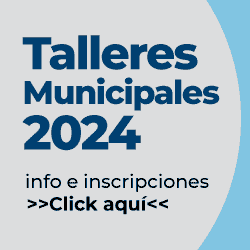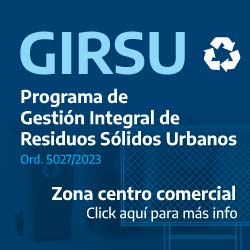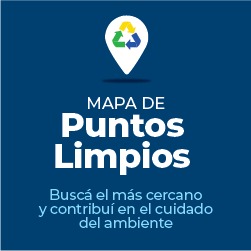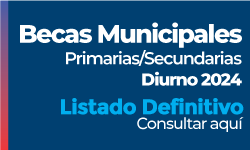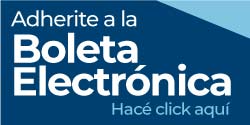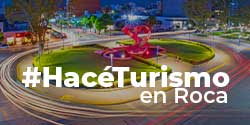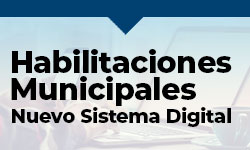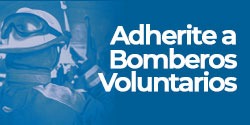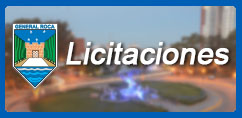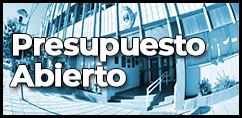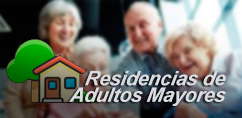Tourist Guide
Urban Tourism
Roca offers a great variety of recreational and cultural activities. Since its foundation, the city has had a remarkable cultural profile, thanks to the people and to different institutions. Citizens with artistic interests started to sow the seeds that have blossomed into today’s cultural expressions.
Walks, Monuments, Museums and Cultural Centres are some of the interesting spots to visit.
Walks
Paseo de la vía (Railway walk)
This is a recreational circuit where many people also work out. From San Juan Street to
Australia Street, the recently landscaped areas, sidewalks and lights offer a safe and pleasant
place to take a stroll.
An interesting tourist attraction within this circuit is Paseo Contemporáneo, located on the
platform of the railways between Avenida Roca and España Streets, where young and
renowned local artists display a number of different sculptures.
This walk combines nature with art and has become an outstanding place in the beautiful, green
and modern city of General Roca.
Paseo del Canalito (Canalito Walk)
The 3rd Secondary Irrigation Canal named “Canal de los Milicos” runs along the city eastwards,
between Isidro Lobo St. and Irigoyen St.
Despite its secondary status, it is the locals’ favourite because it is surrounded by green areas,
public parks and playgrounds. It is the perfect place to practise sports, relax and enjoy a bit of
music in the amphitheatre together with friends or in a family atmosphere. The “Canalito” has
also become a place of tribute to all the different towns and villages that make up the Alto Valle
of the Rio Negro Province because its parks are named after them.
During January, one of the most important activities is the “Artists in Action” festival organized
by the Municipality. Every Sunday afternoon, this festival offers an environment for the cultural
expression of the most outstanding local artists in the different music styles (jazz, rock, national
folk music, cumbia, etc), dance and theatre performers and puppeteers from different local
groups who have a common denominator: “being from Roca City”.
Paseo del Canal Grande (Big Channel Walk)
General Roca is located in the geographic centre of the Alto Valle (Upper Valley) of the
provinces of Río Negro and Neuquén. This valley is the biggest artificially irrigated valley of
Argentina. The irrigation system, built more than a hundred years ago, is derived by gravitation
from the Main Irrigation Canal (20 meters wide and 130 meters long) where a network of 684
km. of secondary and terciary canals turns into 1228 km. of communal irrigation canals and
ditches that irrigate the productive lands.
The Main Irrigation Canal is the core which allows the development of the economy of the area.
The stretch of the Canal situated between Route 6 and Jujuy Street has been recently paved, to
prevent water filtrations and water table problems.
Alongside both margins of the Canal, from San Juan Street to Mendoza Street, an intensive
improvement of the area has taken place including landscapes, sidewalks, benches, safety bars
and modern lights. This circuit called “Paseo del Canal Grande” has become one of the main
attractions of the city, offering an area for recreation and relax, surrounded by the beautiful
scenery, lush vegetation, modern infrastructure and the freshness of the water flowing.
In this circuit, on the north margin and Maipú Street, there is a dry square with a dynamic
architectural design and a water fountain. The square and the skate track are among the
attractive places to visit in this circuit.
Paseo del Bicentenario (Bicentennial walk)
This walk, built in honour of the 200th anniversary of the country’s independence, embellishes
and modernizes one of the main accesses to the Negro river, as well as provides a different
area for those who enjoy working out. Starting at the enlargement of Viterbori Avenue and to the
south of National Route 22 (this first part of the walk reaches up to Lago Mascardi Street), the
boulevard has four lanes, surrounded by landscapes and extensive lights. Two internal
sidewalks –one for cycling and the other for walking– offer the safety conditions for pedestrians
to circulate safely.
Plaza de la Familia (Family Square)
On Mitre Street almost reaching San Juan Street, there is a square devoted exclusively for the
recreation of families. A playground for children all ages built with recycled materials, a carousel
and a kiosk offer a safe place to enjoy with the whole family.
Plaza Integradora (Integrating Square)
The uniqueness of this square is that it offers a recreational area for children with different
abilities. Within Plaza de las Naciones, located at Uruguay and Sarmiento Streets, this
integrating playground offers accesses and ramps for those with different abilities.
Plazas General San Martín y General Manuel Belgrano (San Martín and General Belgrano
Town Squares)
Both town squares are situated at the heart of the city and were born together with the
foundation of the new Pueblo, after the 1899 flood. The new Pueblo’s most important institutions
were built around them: the Town Hall, the school, the church, etc.
In the year 1927 they were renovated for the first time, the monuments to General San Martín
and General Manuel Belgrano were erected and the town squares were embellished with plants
and grass. It was in January 1928 that they were officially named after the two Generals whose
monuments they so proudly exhibit.
In the year 1970 they were totally renovated, lights were added, concrete paths were built, and
they were ornamented with varied trees and flowers.
In the year 2009 the Monument to Motherhood, located in Plaza Belgrano, was remodel led
adding a beautiful fountain to it.
Both town squares, located between España, Sarmiento, San Martín and Mitre Street are a
historical landmark in the city as well as a place for recreation and enjoyment under the shade
of majestic and imposing eucalyptus trees.
Skateboarding rink
This brand new rink for skateboarders is part of the remodelling plan carried out in the northern
part of the city’s main irrigation canal. Today it is one of the main attractions bringing together
hundreds of young people. It is totally free and is also the first skateboarding rink ever built in
the whole Valley.
The project was presented to the Town Hall by a group of kids and it was immediately decided
to build this modern rink of 60 by 20 m equipped with all the necessary structures used for
skateboarding tricks and ready to be used for regional and even national skateboard
competitions.
Commercial and Shopping Area
This is the part of the city which concentrates most of the shops and is located on Tucumán,
Mitre and 25 de Mayo Street, between San Juan and Mendoza Street. It is true that there are
other areas in the city like for example along Roca Avenue from Route 22 to the main irrigation
canal or along San Juan Street from Hipólito Irigoyen Street to the northern part of the city.
However, it is on Tucumán Street that most people come together; it has become a must for
locals to window shop, buy a little something or have an ice cream or a coffee.
Monuments
Monument to Motherhood
Located in Manuel Belgrano Town Square, at the intersection of Mitre and Sarmiento Street,
this monument is erected inside a beautiful fountain recently built to enhance the view.
Monument to Production
This monument has come to be one of the most sought after places when it comes to photos
tourists want to take with them once they leave the city. It is also known as the “Apple
Monument” and it was built to honour the region’s main economic activity. You will find it in the
traffic roundabout at the intersection of Roca Avenue and Isidro Lobo and Irigoyen Street.
The sculpture represents an apple but it is much more than that. Its base opens as a flower from
which two encircling arms sprout to embrace it as they take flight to heaven. The fruit is
accompanied by tall water spurts at its sides which resemble poplars, the majestic protectors of
the crops throughout the whole valley. This monument is a tribute to the economic growth and
development of the Alto Valle in Río Negro province.
Monument to Favaloro
This monument is located in Dr. René Favaloro Square, at the intersection of Resistencia and
República Dominicana Street.
It is an 8 m high stainless steel piece symbolizing the thoracic cavity with an acrylic sphere in
the middle that symbolizes the heart. This sphere is equipped with an inner light that changes its
intensity to represent the beating of the heart. The monument was inaugurated on the city’s
130th anniversary and it is meant to honour the prestigious Argentinian cardiac surgeon.
Plaza de las Naciones (The Square of Nations)
This square was inaugurated on November 1964 hoping to hoist the flags of those nations that
had established amicable relationships with Argentina.
The Square of Nations was recently renovated and now offers a modern green space for
recreation, as well as the possibility to experience a symbolic encounter with our brother
nations.
The other flags swaying in the breeze accompanying our Argentinian Flag represent those first
settlers and colonists that officially settled down in our city. They are: Germany, Armenia, Chile,
Spain, Italy, Israel, France, Lebanon and the Native Peoples.
Museums
Museo Municipal Lorenzo Vintter (Lorenzo Vintter Municipal Museum)
The Historical Museum was founded under the initiative of the teacher Manuel José Félix
Arenaza together with a group of neighbours. They then decided to honour the city’s founder,
Lorenzo Vintter, by naming the museum after him.
The museum first occupied a place within Julio Argentino Roca Library and then moved to the
old municipal building, located in 1650 España Street. Finally, it found its permanent location in
the building that once belonged to the Infant’s Patronage so it is now located on Buenos Aires
Street at the intersection with Artigas Street.
The museum was run by the Government of Río Negro until the year 2007. Because of the
critical condition the building was in, the city’s Town Hall decided to take over the administration
in order to make a massive reconstruction.
The museum’s main objective is to preserve and encourage love and respect for our past
traditions. It keeps a collection of more than 800 pieces and also contains an important
inventory of documents, books and photos.
The museum provides guided tours but they must be requested in advance. It also offers
personalized attention to the public and an information centre with brochures and pamphlets.
Museum hours:
Tuesday to Friday, from 9 am to 12 pm and 3 pm to 6 pm
Sunday and Bank Holidays, from 4 pm to 7 pm
Contact: Tel.+55 02941 427227 – E-mail: museovintter@generalroca.gov.ar
Address: Buenos Aires and Artigas Street
Museo Municipal de Bellas Artes “Juan Sánchez” (“Juan Sánchez” Municipal Museum of
Fine Arts)
Created in 1983, it was named after Juan Sánchez, the plastic artist, and is directed to promote
the plastic arts at a local, regional and Patagonian level.
The Museum’s collection rises to 110 works of art of which 62 are paintings and the rest are
drawings, etchings and sculptures. The collection has been growing strong thanks to donations
from the National Arts Fund and from other different artists.
Contact: Phone (02941) 433602
Address: Kennedy and 25 de Mayo Street
Museo Patagónico de Ciencias Naturales (Patagonian Museum of Natural Sciences)
The museum is in the modern and large three-floor building located in the centre of the City.
At the entrance of the building you will find the Reception hall and a small stand where
handicrafts are exhibited and sold.
Upstairs you can appreciate a complete and modern didactic circuit of Palentological Geological
and Mineralogical data.
Children will enjoy the wonderful reproduction of a dinosaur exhibited in this museum.
There are two laboratories. In the “Earth Sciences” lab, experts are working on the restoration
and preparation of palaeontological material for research and exhibition. In the “biodiversity” lab,
experts are working in entomology (preparation and labelling of insects) and in micrommals.
Museum hours:
From Wednesday to Saturday from 9 am to 12 pm and from 5 pm to 9 pm and Sunday from 3
pm to 10 pm.
You can enjoy a guided trip on request.
Contact: Phone (02941) 420030 – E-mail: fundacionpatagonica@yahoo.com.ar
Address: Avenida Roca 1250
Cultural Centres
General Roca is known for its cultural activity and also for its cultural production. Theatre,
music, dance, tango, plastic arts, murgas, among others, make of Roca a city which offers a
wide range of cultural alternatives throughout the year.
Roca’s first settlers left their cultural imprint transforming Roca into a city different from all the
others in the Valley. That is why there are so many places to meet with the arts, not only for
permanent residents but also for tourists.
-
TELÉFONOS ÚTILES
Policia 101
Bomberos 100
Ambulancia 107
Defensa civil 103 -
HORARIO DE ATENCIÓN:
Lunes a Viernes de 8:00 a 19:00 hs
Consultas, denuncias y reclamos
0800-222-9742
-
TELÉFONOS MUNICIPALES
CONTACTOS
WEBMAIL
GDE

